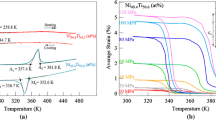Abstract
The shape memory effect associated with the reverse transformation of deformed martensite, pseudoelastic behavior involved in stress-induced martensite formation and the reversion of strained martensite after an applied stress is relaxed aboveA f have been studied. Grain size and specimen geometry effects have been related to the above phenomena. Although recoverable strains as high as 10.85 pct were observed in coarse-grained (“bamboo” type) specimens, the shape memory effect is restricted in fine-grained specimens because of permanent grain boundary deformation and intergranular fracture which occurs at relatively low strains. A fine grain size also acts to suppress pseudoelastic behavior because permanent, localized deformation is generated concurrent with the formation of stress-induced martensite which inhibits reversion of the latter upon release of stress. The apparent plastic deformation of martensite belowM f can be restored by transforming back to the original parent phase by heating toA f (shape memory) or alternatively, can be recovered belowM f by applying a small stress of opposite sign. Martensite deformed belowM f with the same stress maintained while heating persists aboveA f, but reverts to the parent phase in a pseudoelastic manner when the stress is relieved. The athermal thermoelastic martensite, which forms in groups composed of four martensite plate variants, undergoes several morphology changes under deformation. One of the variants within a plate group cluster may grow with respect to the others, and eventually form a single crystalline martensitic region. At a later stage pink colored deformation bands form in the same area and join up with increasing stress, resulting in thermally irreversible kinks. The clusters of plate groups may expand like grain growth or contract as a whole during deformation, or act as immobile “subgrains” which lead to permanent deformation at their boundaries. Stress-induced martensite usually forms as one variant of parallel plates which join up with increasing stress to form single crystalline regions. Further stress leads to pink colored deformation bands, similar to those in the deformed athermal martensite. Other similarities and differences between the stress-induced and athermal martensite have been investigated and are discussed.
Similar content being viewed by others
References
J. D. Eisenwasser and L. C. Brown:Met. Trans., 1972, vol. 3, p. 1359.
C. M. Wayman and K. Shimizu:Metal Sci. J., 1972, vol. 6, p. 1975.
L. C. Chang and T. A. Read:Trans. AIME, 1951, vol. 191, p. 47.
F. E. Wang, J. W. Buehler, and S. J. Pickart:J. Appl. Phys., 1965, vol. 36, p. 3232.
H. Tas, L. Delaey, and A. Deruyttere:Scr. Met., 1971, vol. 5, p. 1117.
K. Otsuka and K. Shimizu:Scr. Met., 1970, vol. 4, p. 469.
C. M. Wayman:Scr. Met., 1971, vol. 5, p. 489.
D. V. Wield and E. Gillam:Scr. Met., 1972, vol. 6, p. 1157.
Z. S. Basinski and W. J. Christian:Acta Met., 1954, vol. 2, p. 161.
I. Cornelis and C. M. Wayman:Scr. Met., 1974, vol. 8, p. 1321.
Y. K. Au and C. M. Wayman:Scr. Met., 1972, vol. 6, p. 1209.
J. W. Christian:The Theory of Transformations in Metals and Alloys, p. 789, Pergamon Press, New York, 1965.
T. Tadaki, M. Tokoro, and K. Shimizu:Trans. Jap. Inst. Metals, 1975, vol. 16, p. 285.
W. Arnado and M. Ahlers:Scr. Met., 1973, vol. 7, p. 1287.
H. Pops:Met. Trans., 1970, vol. 1, p. 251.
W. A. Rachinger:J. Aust. Inst. Metals, 1960, vol. 5, p. 114.
L. Delaey, R. V. Krishnan, H. Tas, and H. Warlimont:J. Mater. Sci., 1914, vol. 9, p. 1536.
I. Cornelis and C. M. Wayman:Acta Met., 1974, vol. 22, p. 291.
H. Pops and T. B. Massalski:Trans. TMS-AIME, 1964, vol. 230, p. 1662.
S. Sato and K. Takezawa:Trans. Jap. Inst. Metals, 1968, vol. 9, p. 925.
R. D. Garwood and D. Hull:Acta Met., 1958, vol. 6, p. 98.
I. Cornelis and C. M. Wayman:Acta Met., 1974, vol. 22, p. 301.
I. Cornelis: Ph.D. Thesis, University of Illinois, 1973.
R. E. Hummel and J. W. Koger:Trans. TMS-AIME, 1968, vol. 242, p. 154.
R. E. Hummel and J. W. Koger:Trans. TMS-AIME, 1968, vol. 242, p. 1754.
K. A. Thornburg, D. P. Dunne, and C. M. Wayman:Met. Trans., 1971, vol. 2, p. 2302.
L. Delaey, J. Van Paemel, and T. Struyve:Scr. Met., 1972, vol. 6, p. 507.
I. Cornelis and C. M. Wayman:Mater. Res. Bull., 1974, vol. 9, p. 1057.
R. E. Hummel:Z. Metallk., 1968, vol. 59, p. 153.
Author information
Authors and Affiliations
Additional information
Formerly with the University of Illinois at Urbana-Champaign
Rights and permissions
About this article
Cite this article
Schroeder, T.A., Cornelis, I. & Wayman, C.M. The shape memory effect and pseudoelasticity in polycrystalline Cu-Zn alloys. Metall Trans A 7, 535–553 (1976). https://doi.org/10.1007/BF02643969
Received:
Issue Date:
DOI: https://doi.org/10.1007/BF02643969




